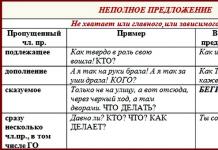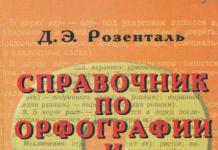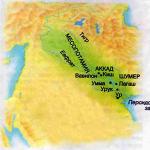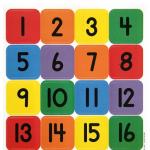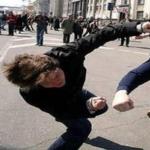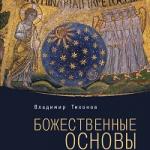1.3. Main structural components of the dictionary
Each dictionary consists of a number of components that provide the reader with access to the information it contains. The first essential component is dictionary dictionary The dictionary includes all units that form the description area of the dictionary and are inputs to dictionary entries. In fact, the dictionary specifies the scope of the dictionary description. As such, the vocabulary is usually not highlighted separately in the dictionary. A vocabulary can consist of morphemes (for morpheme and grammar dictionaries), lexemes (for example, for explanatory dictionaries), word forms (for grammar dictionaries) and phrases (for example, for phraseological dictionaries, idiom dictionaries, syntagma dictionaries). The elementary unit of the dictionary is dictionary entry- each individual object of the dictionary description and the dictionary characteristics associated with it. A set of dictionary entries forms the main text of the dictionary. A separate structural component is formed pointers, or indices. In a regular explanatory dictionary, pointers are quite rare. The situation is completely different with phraseological dictionaries and dictionaries of idioms. Since the basic form of phraseological units is subject to strong variation - put your teeth on a shelf And put your teeth on a shelf put your teeth on a shelf, warm/warm/warm your hands (on smth.) warm hands/warm/warm (on smth.)
- any chosen method of organizing the dictionary does not provide easy searching. To facilitate the search for the desired idiom, indexes are created in phraseological dictionaries that allow you to find an idiom by any of its components. Indexes are often included in the structure of thesauruses and bilingual dictionaries. Thesaurus indexes make it possible to determine which taxa a particular word belongs to, and the indexes of bilingual dictionaries partly perform the functions of a reverse dictionary in relation to a given one. An important structural part of a linguistic dictionary is list of sources
. It is absolutely necessary for the European dictionary tradition, since the use of any already published text materials (including in examples) requires appropriate permission from the copyright holder. A special part of the dictionary can be considered introductory article.
1.4. Main structural components (zones) of a dictionary entry
, which explains the principles of using the dictionary and contains information about the structure of the dictionary entry. Sometimes the structure of a dictionary entry is placed in a special section of the dictionary. In addition, linguistic dictionaries usually include list of abbreviations and alphabet descriptions. Each zone contains a special type of vocabulary information. First zone - lexical input dictionary entry, vocabulary or lemma. Vocables often indicate stress. Lexical input is usually marked in bold. Therefore, in the jargon of lexicographers and editors, this zone is often called the “black word”. In the explanatory dictionary, the lexical entry is most often followed by the zone grammatical information and zone stylistic litter.
In explanatory dictionaries, as grammatical information about a word, the part of speech and characteristic grammatical forms are indicated (for example, for nouns - the genitive case form and an indication of gender). The complex of stylistic marks gives an idea of the restrictions on the use of the word: literary language vs.
dialects, the term follows
value zone
, which is divided into separate subzones:
value number;
additional grammatical and stylistic notes; interpretation zone; example/illustration area;
zone of shades of meaning. In explanatory dictionaries, the dictionary entry, as a rule, is.
zone of phraseological units
.
Since the zone of phraseological units is usually marked with a diamond sign, in the jargon of lexicographers it is called the “diamond” zone.
1
isit
, -shu, -shish;
2
Pushkin, Scenes from Knightly Times [
♦
Kostya
Turgenev, Unhappy. Rice. 1 Verb dictionary entry
deprive
Each type of linguistic dictionary is characterized by its own dictionary entry structure. Thus, normative and descriptive dictionaries differ not only in the choice of material, but also in its organization in the dictionary.
Normative dictionary
Lexical input (vocabula).
Stylistic mark.
Grammar information.
Interpretation.
Examples of use.
Normative dictionary
Descriptive dictionary
Options.
Stylistic mark.
Grammar information.
Interpretation.
Litter areas of use.
Examples of non-standard usages.
Idiomatic zone (stable combinations, phraseological units).
Thus, a descriptive type dictionary represents, as far as possible, all the features of the use of a word, and a normative one pays attention to the literary standard, dividing vocabulary into stylistic areas and forming a standard of literary language.
Frequency dictionaries, dictionaries of metaphors and epithets have a completely different structure of dictionary entries. For example, there is practically no interpretation zone in them. The concept of a dictionary entry is somewhat blurred for thesauruses, since they reflect the hierarchy of semantic relations within the lexicon. If the thesaurus represents a tree of genus-species relations in its pure form, then the entire text can be considered a single dictionary entry. For this reason, as noted above, in relation to the structure of the thesaurus, the concept is more often used taxon
, which is understood as any set of words, phrases (and even morphemes) that are associated with a single semantic description in terms of thesaurus descriptors. In other words, a taxon is a set of description units united into a group on common semantic grounds at any level of abstraction.
For taxa at a high level of abstraction, it is better to talk about the hierarchical structure of a dictionary entry. The latter appears in the thesaurus as a set of hierarchically ordered terminal taxa that form taxa of higher levels.
Wed. below is a set of terminal taxa forming the taxon TIME from the Thesaurus of Russian Idiomatics [Baranov, Dobrovolsky 2000] Dictionary entry
- the basic structural unit of any dictionary.
- The dictionary entry consists of:
- capital unit;
text explaining the heading unit and describing its main characteristics.
Left side of the dictionary. The dictionary entry of any dictionary begins with capital word(in other words: head word, lemma, black word - from the bold font that usually marks the head word).
The combination of capital words forms dictionary, or the left side of the dictionary. The choice of a dictionary (which words will be included in a given dictionary and which will not) depends on the purpose of the dictionary (highly specialized, universal, etc.).
A dictionary may consist of language units:
- phonemes (sounds) - have recently been widely developed in connection with the development of automatic speech recognition;
- morphemes (prefixes, roots, suffixes..) - for morpheme dictionaries, grammar dictionaries, derivational dictionaries;
- lexemes (words in the “basic form”) - most dictionaries are built according to this criterion: explanatory, spelling, etc.;
- word forms (words in a certain number, case..) - for grammatical dictionaries, rhyming dictionaries, etc.;
- phrases (not one word, but several related words in one way or another) - for example, for phraseological dictionaries, dictionaries of idioms, dictionaries of cliches, etc.
Sometimes the vocabulary consists of lexemes and phrases (for example, for encyclopedic dictionaries).
Right side of the dictionary- the one in which the heading unit is explained. The structure of a dictionary entry is determined by the tasks of the dictionary. Zones on the right side are developed for each dictionary. This could be: a list of synonyms for a given word (for a dictionary of synonyms), a translation of the word (for dictionaries of foreign words), a disclosure of the concept that is described by a given word, with the possible application of graphs, diagrams, drawings (for encyclopedic dictionaries), etc. For example , the right side of the explanatory dictionary, as a rule, includes the zones:
- grammatical;
- stylistic;
- interpretation;
- illustrations (quotes, sayings);
- type of meaning (direct, figurative);
- word-formation nest;
- the so-called “diamond” part (phraseologisms);
- and etc.
Often inside a dictionary entry there may be region (zone) litter(or simply litters). Marks can be stylistic, grammatical and others. Most often, marks are located immediately after the heading word, but they can also be in other places (for example: outdated- outdated meaning, rare- meaning rarely used, scientific- scientific significance, etc.)
The totality of all dictionary entries forms dictionary body. In addition to the body, any dictionary usually has a preface, a section “How to use the dictionary”; a list of abbreviations, etc. In addition, dictionaries may contain pointers (in Wikipedia, the role of pointers is partially played by redirection pages, “ambiguity” and “Categorization” pages)
Example
Dictionary entry “Product” in the Explanatory Dictionary of the Russian Language, edited by D. N. Ushakov.
PRODUCT, a (y), m. 1. (plural meaning different types, varieties). A product of labor that has value and is distributed in society through purchase and sale (economics); in general, everything that is an item of trade. (Stalin). (Zhukovsky). Red t.(see red). There are a lot of goods in the stores. Hot t. Lying t. Colonial t. 2. (units only). Tanned finished leather (boots). Opoikovy T. 3. (units only). Ore mixture ready for smelting (forge). ◊ Living goods. See live in 6 digits. Show the product face- show something from the best, most advantageous side. An auditor is coming from St. Petersburg... You could hear that everyone was cowardly, fussing, wanting to show off the goods with their faces(Dostoevsky).
Case Study
PRODUCT- headword;
a (y) - grammatical zone: indicating the ending in gender. p.un. h., the ending option is given in brackets;
m. - grammatical zone: indicating the gender of the word, it is masculine;
1. - number of the meaning of a polysemantic word (for single-valued words the number is not indicated);
(plural meaning different types, varieties) - grammatical zone of the first meaning: it is indicated that in the plural this meaning of the word does not have the meaning of plurality (which is characteristic of the grammatical meaning of the plural), but the meaning “different types, varieties”;
A product of labor that has value and is distributed in society through purchase and sale - interpretation of the first meaning;
(economy) - stylistic zone: an indication of the limitation of this meaning to special vocabulary, namely economic;
in general, everything that is an object of trade is the second part of the interpretation of the first meaning, a sign; before this part of the interpretation indicates that it can potentially be isolated into a separate meaning;
We must finally understand that goods are ultimately produced not for production, but for consumption.
My ship anchored in the bay is full of rare goods- illustration area: a quote is given as an example;
Red t.- illustration zone: a sentence is given as an example - a stable expression;
(see red) - zone of reference: with the help of this zone, a connection is established between the elements of the dictionary: the reader is referred to the dictionary entry “red”, which provides an interpretation of the phraseological unit red product;
There are a lot of goods in the stores- illustration zone: a speech is given as an example;
Hot t. Lying t. Colonial t.- illustration zone: sayings are given as examples, pay attention to the last example - today it should be given in the diamond part or with a hint, since this is historicism;
2.
Tanned finished leather is a zone of interpretation;
(boot) - stylistic zone: indication of the area of restriction of use;
Opoikovy T.- illustration zone: a speech is given as an illustration;
3. - number of the meaning of a polysemantic word;
only units - grammatical zone: a restriction is indicated for this meaning, only in the singular;
Ore mixture ready for smelting - interpretation;
(horn) - stylistic zone: indication of the scope of restriction of use;
◊ - a diamond sign, after which the “behind the diamond part” begins, where phraseological units are presented. Each phraseological unit also has its own entrance, its own black words, they (despite the fact that there are at least two of them) represent one lexical unit;
Live goods- the head word of the diamond part;
See live in 6 digits. - interpretation-reference, the reader should turn to the word living in the 6th meaning, where the interpretation of the phraseological unit living commodity will be given. It would be good to repeat the interpretation rather than send it, but if you consider that in Ushakov’s time dictionaries were always only printed, then it is immediately obvious that references save paper;
Lesson type: speech development lesson, 6th grade, 2 hours
Subject: Compiling a dictionary entry for linguistic and encyclopedic dictionaries.
Equipment: handouts (examples of dictionary entries, cards for the game “Collect a dictionary entry”), computer presentations of the teacher and children. There are no dictionaries in the lesson so that the children have the opportunity to complete the task independently. Proverbs written on pieces of multi-colored paper.
Goals: 1. Formation of basic knowledge about lexicography, the ability to create a dictionary entry.
2. Development of the concept of scientific style, the ability to construct a coherent statement.
3. Cultivating an attentive attitude to the word and material given in dictionaries.
During the classes
1. Greeting, division into groups.
Hello guys. Before you enter the class, I invite everyone to choose a proverb that is clear and close to you more than others. (On the table in front of the classroom there are four groups of proverbs printed on sheets of different colors)
Kind words are better than soft pie. (yellow)
You recognize a donkey by its ears, and a fool by its words. (Red color)
From word to deed - a grandmother's mile. (A verst is a little more than a kilometer) (blue color)
The word is silver, silence is gold. (green color)
Have you chosen proverbs? Please sit down at the table on which there is a card of the same color as your proverb.
2. Setting lesson goals.
A) Group work
As a group, compose a text of 3-4 sentences explaining the meaning of your proverb. (Reading thumbnails, discussion)
Tell me, please, what are all your proverbs about? (about words)
B) Recording and analyzing the proposal.
The language keeps many very ancient words and roots in its treasury... (Lev Vasilyevich Uspensky, “A Word about Words”)
What treasury is Lev Uspensky talking about? (vocabulary, lexicon)
Where do you think these treasures are kept? (in dictionary)
So, today we will talk about dictionaries and dictionary entries. You will become the authors of dictionary entries. The treasury we will be working with has its own secrets. Let's try to reveal them.
3. Introduction to the subject of study.
A) Teacher’s presentation “Dictionaries”
B) Individual children's tasks.
Individual task: prepare a message (possible using a computer presentation) on the topics “Explanatory Dictionary of the Living Great Russian Language” by V. I. Dahl, “Explanatory Dictionary of the Russian Language” by S. I. Ozhegov, as well as a message about any encyclopedic dictionary.
B) Teacher’s presentation “Dictionary entry”
D) Comparison of dictionary entries from linguistic and encyclopedic dictionaries.
CLOUDS, accumulations of water droplets and ice crystals suspended in the atmosphere. O. Ch. are formed. arr. in the troposphere; they are distinguished by height: O. top. tiers (above 6 km) - cirrus, cirrostratus, cirrocumulus - consist of ice crystals; O. Wed. tiers (2-6 km) - altostratus and altocumulus - consist of tiny drops and ice crystals; O. lower layers (below 2 km) - stratus, stratocumulus and nimbostratus - consist predominantly. from drops. O. arise as a result of condensation of water vapor contained in the air. The diameters of cloud drops are of the order of several. microns, the content of liquid water in O. is a fraction of a gram or several. grams per m³. As some of the drops and crystals become larger, they fall out of the atmosphere in the form of atm. precipitation. Pearlescent ones are also observed in the stratosphere, and silvery ones are observed in the mesosphere.
CLOUD, -a, pl. -á, -ov, cf. 1. Light gray clouds, wavy layers in the sky, a cluster of water droplets and ice crystals condensed in the atmosphere. Clouds are floating across the sky. The wind drives the clouds. Cumulus clouds. Thunderstorm, rain o. Up to the clouds (translated: very high). Descend from the clouds (translated: from dreams to turn to reality; ironic). to fall or fall from the clouds (translated: about the unexpected appearance of someone; colloquial). 2. trans., what. A solid mass of something. small volatile particles. O. smoke, steam. // decrease cloud,-a, pl. - á, -ov, middle// adj. cloudy,-th, -oe (to 1 value). O. layer.
Determine which dictionary these articles are from and prove it. (1 - encyclopedic dictionary, because it describes a natural phenomenon, 2 - linguistic, because it describes a word, a unit of language)
What is described in the dictionary entry of the encyclopedic dictionary? What is the nature of the information given in this article? (About the nature of clouds, the place of formation, types of clouds, the information given in the article is of a scientific nature: terminology, numerical data)
What information can be gleaned from another dictionary entry? (Lexical meaning of the word, grammatical features, examples of use...)
The teacher draws students' attention to the style of dictionary entries.
D) Game “Collect a dictionary entry”
Each group receives its own set of cards, on which there are different areas of the dictionary entry. They are mixed up, they need to be put in order.
VELENKI, -nok, units -nok, -nka, m. Winter soft boots felted from wool. Hemmed in. (with sewn leather or felt sole). // adj. felt boots,-oh, -oh.
ZODIAC, -a, m. (special). The belt of the sky along which the Sun makes its apparent annual movement. Zodiac signs (designation of the 12 constellations through which the zodiac passes). // adj. zodiac, oh, oh.
FOX, -y, w. Predatory mammal of the family. canids with a long fluffy tail, as well as its fur. Red L. // decrease fox, -i, w.
SUBURB, -a, m. Village, settlement adjacent to a large city. Live in the suburbs. // adj. suburban, oh, oh.
4. Compilation of a dictionary entry for encyclopedic and linguistic dictionaries (group work).
Instructions.
I. Compose an article for a linguistic dictionary.
Indicate the accent in singular. and plural
Determine the ending in the genitive singular case. and nominative and genitive cases in the plural.
Give the proposed word an interpretation.
Give an example of using this word in speech.
Write down the diminutive form, if any, and an example of the use of this form.
Write down an adjective formed from this word, an example of its use.
II. Compose an article for an encyclopedic dictionary.
Talk about the nature of the object (what is it?)
Describe the main properties (what is it?)
List possible types.
Words for working in groups.
1. Flower - yellow color
2. Vegetable - red color
3. Wood - blue color
4. Berry - green color
5. Registration of dictionary entries.
Articles are drawn up on A4 sheets; illustrations can be used in a dictionary entry for an encyclopedia.
6. Lesson summary.
Remember how in the fairy tale “Alibaba and the Forty Thieves” only the one who knew the secret word could open the cave with treasures? So you and I have lifted the veil of secrecy, which will help us join the treasures of the Russian word. And at home, I suggest you make a dictionary of 8-10 words on the topic “New Year”. What kind of dictionary will it be? You decide. Perhaps you will combine the features of two dictionaries in one! Go for it!
Content:
Whether you're planning to create your own glossary, write a dictionary, look convincing in a game of stupid dictionary, or write definitions for your own words, here are some ideas to help make your definitions as accurate and concise as possible. These steps are appropriate for descriptively defining how a term is used in a language. Keep in mind that this is quite a labor-intensive process, requiring much more effort than a prescriptive definition, which dictates how the writer should use a given term in writing.
Steps
- 1 Find examples of how the word is used. Google (and especially Google Books) is a great way to find quotes. And the quotes, in turn, prove that this word is actively used, and perfectly show in what or what senses.
- 2 Study how the word is used and functions in the examples you find.
- 3
Determine the part of speech of the word in the sense or senses you want to define. Keep these basic points in mind:
- Noun: person, place or thing: Utah, minibus, moon, greengrocer, January. Nouns can also refer to abstract concepts such as certainty or doubt.
- Pronoun: A word that is used in place of a noun. He, she, it, they.
- Verb: a word that denotes action. Walk, jump, rant, fry, stare, ponder, hurry.
- Adjective: a word that describes a noun. Red (hat), fast (train), unreliable (bar).
- Adverb: A word that describes or modifies the meaning of a verb or adjective. (He fell and) hurt (hit, then) slowly (rose). (The train was moving) terribly (slowly).
- Conjunction: a word that joins parts of a complex sentence. In Russian, this list includes the words and, or, as, as if, and...and, neither...nor, too, but, so that, also, because, etc.
- Preposition: a word that describes the position of something. On, over, under, to, in, at, inside, etc.
- Interjection: An emotional exclamation usually unrelated to the grammatical structure of the sentence. For example: Wow! Hey! Ugh! Abracadabra! Oh! Hmm... Wow!
- 4 Carry out further classification within one part of speech. If you want to thoroughly understand the grammatical function of this word, determine whether the noun is countable or uncountable, whether the verb is transitive or intransitive, etc.
- 5 Choose one of the meanings of the word and think about its meaning in this context. The simpler you can define this word, the better, so try to imagine that you are trying to explain this word to a child or someone who is just learning to speak your language. Avoid using descriptive words that are even more complex than the word being defined, unless you are trying to explain their meaning along the way.
- 6 Explore the word. What other words sound similar to it? What words are close to it in meaning? What is the difference between this word and its synonyms? For example, what distinguishes the word “fragile” from “weak” or “breakable”?
- 7 Think about what synonyms (words with similar meanings) and antonyms (words with opposite meanings) exist for the word being defined.
- 8
Some of them may end up in your dictionary entry, if they fit there. Describe the word being defined.
- Although it is perfectly acceptable to include synonyms in a definition, such a definition, composed entirely of synonyms, cannot provide comprehensive information about the meaning of a word. Therefore, make every effort to describe the word you are defining.
- If a word has multiple meanings, you will have to define each one separately.
- 9 To write a definition of a word, use words that will be familiar to a person who will read this definition for the first time, without knowing the meaning of the concept being defined.
- Compare:
- 10 Courage - courage, boldness, audacity. Courage is emphasized determination, strength of spirit.
- 11
Write the definition of the word using typical dictionary style. You can start with sentences like “This word is used ...” or “It describes a situation in which ...”, but it is better to remove them from the final version of your definition.
- Write the definition so that it matches the part of speech being defined.
- Verb definitions themselves must contain many verbs, noun definitions themselves must contain many nouns.
- Most verb definitions must begin with the verb in the indefinite form. For example, the definition of the verb “to stop” might be: “to pause or stop for a while; interrupt a process or some action and start it again later.”
- 13 It is better to start defining nouns with nouns too.
- 12 Read your definition and make sure it matches the word you are defining and the meaning of that word you want to describe.
- Have someone read your definition and comment on it.
- Read definitions from dictionaries and glossaries and make notes on the style in which they are written.
- Look at how your word is defined in other sources. Synthesizing definitions that someone has already written will help you write your own or help you learn to write definitions of words yourself.
- If you're interested in the fascinating history of the Oxford English Dictionary, check out this.
- If you are just learning to write dictionary definitions, then you should start with words with a narrow, specific meaning, especially nouns. Just compare the number of meanings and definitions for such specific words as "souvenir" or "twitter" with the number of meanings and definitions for such commonly used words as "bottom" or "current" and you'll see why. Start practicing first with non-ambiguous, highly specialized words.
- Sometimes determining the part of speech of a word can be quite difficult. If you are not completely sure which part of speech you are dealing with, then it is better to check the dictionary. If things are really bad, then look in a grammar reference book. These kinds of books contain about 3,000 difficult words.
Warnings
- Avoid definitions that tell you what a word is not, and focus instead on what it is.
- Try to avoid circular definitions, especially if you are writing a definition for several words. When writing definitions for words, there is a tendency at the end of the definition to return to the defined word or to the same root word. It may be quite acceptable to define an adverb using a cognate adjective (for example: strange - in a strange way), but this type of definition assumes that the adjective “strange” is already defined or known in advance. In general, it is better to avoid using cognate words in the definition.
- If you decide to include information about the origin of a word in your dictionary entry, make sure you do your research first. Some words have several “folk” versions of their origin. Usually these theories have no basis and are passed on by word of mouth without any adequate confirmation. Do your own research and adequately evaluate whether your sources can be trusted.
- The parts of speech listed above are basic and common to most European languages. Other languages may have other parts of speech, and some scholars identify additional parts of speech in European languages.
text explaining the heading unit and describing its main characteristics.
Left side of the dictionary. The dictionary entry of any dictionary begins with capital word(in other words: head word, lemma, black word - from the bold font that usually marks the head word).
The combination of capital words form dictionary, or the left side of the dictionary. The choice of a dictionary (which words will be included in a given dictionary and which will not) depends on the purpose of the dictionary (highly specialized, universal, etc.).
A dictionary may consist of language units:
- phonemes (sounds) - have recently been widely developed in connection with the development of automatic speech recognition;
- morphemes (prefixes, roots, suffixes..) - for morpheme dictionaries, grammar dictionaries, derivational dictionaries;
- lexemes (words in the “basic form”) - most dictionaries are built according to this criterion: explanatory, spelling, etc.;
- word forms (words in a certain number, case..) - for grammatical dictionaries, rhyming dictionaries, etc.;
- phrases (not one word, but several related words in one way or another) - for example, for phraseological dictionaries, dictionaries of idioms, dictionaries of cliches, etc.
Sometimes the vocabulary consists of lexemes and phrases (for example, for encyclopedic dictionaries).
Right side of the dictionary- the one in which the heading unit is explained. The structure of a dictionary entry is determined by the tasks of the dictionary. Zones on the right side are developed for each dictionary. This could be: a list of synonyms for a given word (for a dictionary of synonyms), a translation of the word (for dictionaries of foreign words), a disclosure of the concept that is described by a given word, with the possible application of graphs, diagrams, drawings (for encyclopedic dictionaries), etc. For example , the right side of the explanatory dictionary, as a rule, includes the zones:
- grammatical;
- stylistic;
- interpretation;
- illustrations (quotes, sayings);
- type of meaning (direct, figurative);
- word-formation nest;
- the so-called “diamond” part (phraseologisms);
- and etc.
Often inside a dictionary entry there may be region (zone) litter(or simply litters). Marks can be stylistic, grammatical and others. Most often, marks are located immediately after the heading word, but they can also be in other places (for example: outdated- outdated meaning, rare- meaning rarely used, scientific- scientific significance, etc.)
The totality of all dictionary entries forms dictionary body. In addition to the body, any dictionary usually has a preface, a section “How to use the dictionary”; a list of abbreviations, etc. In addition, dictionaries may contain pointers (in Wikipedia, the role of pointers is partially played by redirection pages, “ambiguity” and “Categorization” pages)
Example
Dictionary entry “Product” in the Explanatory Dictionary of the Russian Language, edited by D. N. Ushakov.
PRODUCT, a (y), m. 1. (plural meaning different types, varieties). A product of labor that has value and is distributed in society through purchase and sale (economics); in general, everything that is an item of trade. (Stalin). (Zhukovsky). Red t.(see red). There are a lot of goods in the stores. Hot t. Lying t. Colonial t. 2. (units only). Tanned finished leather (boots). Opoikovy T. 3. (units only). Ore mixture ready for smelting (forge). ◊ Living goods. See live in 6 digits. Show the product face- show something from the best, most advantageous side. (Dostoevsky).
Case Study
PRODUCT- headword;
a (y) - grammatical zone: indicating the ending in gender. p.un. h., the ending option is given in brackets;
m. - grammatical zone: indicating the gender of the word, it is masculine;
1. - number of the meaning of a polysemantic word (for single-valued words the number is not indicated);
(plural meaning different types, varieties) - grammatical zone of the first meaning: it is indicated that in the plural this meaning of the word does not have the meaning of plurality (which is characteristic of the grammatical meaning of the plural), but the meaning “different types, varieties”;
A product of labor that has value and is distributed in society through purchase and sale - interpretation of the first meaning;
(economy) - stylistic zone: an indication of the limitation of this meaning to special vocabulary, namely economic;
in general, everything that is an object of trade is the second part of the interpretation of the first meaning, a sign; before this part of the interpretation indicates that it can potentially be isolated into a separate meaning;
We must finally understand that goods are ultimately produced not for production, but for consumption.
My ship anchored in the bay is full of rare goods- illustration area: a quote is given as an example;
Red t.- illustration zone: a sentence is given as an example - a stable expression;
(see red) - zone of reference: with the help of this zone, a connection is established between the elements of the dictionary: the reader is referred to the dictionary entry “red”, which provides an interpretation of the phraseological unit red product;
There are a lot of goods in the stores- illustration zone: a speech is given as an example;
Hot t. Lying t. Colonial t.- illustration zone: sayings are given as examples, pay attention to the last example - today it should be given in the diamond part or with a hint, since this is historicism;
2.
Tanned finished leather is a zone of interpretation;
(boot) - stylistic zone: indication of the area of restriction of use;
Opoikovy T.- illustration zone: a speech is given as an illustration;
3. - number of the meaning of a polysemantic word;
only units - grammatical zone: a restriction is indicated for this meaning, only in the singular;
Ore mixture ready for smelting - interpretation;
(horn) - stylistic zone: indication of the scope of restriction of use;
◊ - a diamond sign, after which the “behind the diamond part” begins, where phraseological units are presented. Each phraseological unit also has its own entrance, its own black words, they (despite the fact that there are at least two of them) represent one lexical unit;
Live goods- the head word of the diamond part;
See live in 6 digits. - interpretation-reference, the reader should turn to the word living in the 6th meaning, where the interpretation of the phraseological unit living commodity will be given. It would be good to repeat the interpretation rather than send it, but if you consider that in Ushakov’s time dictionaries were always only printed, then it is immediately obvious that references save paper;
Show the product face to face - the title word of the diamond part;
Show something from the best, most advantageous side - interpretation of a phraseological unit;
An auditor is coming from St. Petersburg... You could hear that everyone was cowardly, fussing, wanting to show off the goods with their faces- illustration area: a quote is given as an example;
see also
Links
Wikimedia Foundation.
2010.
See what a “Dictionary entry” is in other dictionaries: A structural unit of a dictionary/encyclopedia, which is a relatively independent text, including a headword in the form of a phrase, expression, concept, term and its explanation, definitions, interpretations, equivalents in others... ...
Technical Translator's Guide The structural part of the dictionary, which is devoted to one topic and which consists of a headword that defines the topic, and the following text of the article. See also Vocabula (2) ...
Publishing dictionary-reference book An article explaining the title word in the dictionary, vocabulary nest. A group of cognate words presented in the form of one dictionary entry...
Dictionary of linguistic terms An article explaining the heading word in the dictionary...
Explanatory translation dictionary An entry in a dictionary that characterizes a particular word and includes various zones. 1. First comes the headword, formatted in such a way that we can get information about its spelling, pronunciation, and stress. Zonal structure of the vocabulary... ...
Dictionary of linguistic terms T.V. Foal A structural unit of a dictionary/encyclopedia, which is a relatively independent text, including a title word (phrase, expression, concept, term) and its explanation (definition, interpretation, equivalents in other languages and... ...
Brief explanatory dictionary of printing
- ... Wikipedia AND; pl. genus. t/y, dat. thya/m; and. see also article, article, article, article, article 1) Scientific, journalistic, popular science essay of small size ...
Dictionary of many expressions
And, gen. pl. article/th, g. 1) A small scientific or journalistic essay in a collection, magazine or newspaper. Article. Digest of articles. Publish an article. And then some very unpleasant thoughts about the article began to swirl in Styopa’s brain... Popular dictionary of the Russian language
Books
- Explanatory Dictionary of the Russian Language, S. I. Ozhegov and N. Yu. Shvedova, The one-volume explanatory dictionary of the Russian language contains 80,000 words and phraseological expressions (counting head words, derivative words placed in the word-formation nest, and ... Category: Russian language. A culture of speech. Reference books and manuals Publisher:
